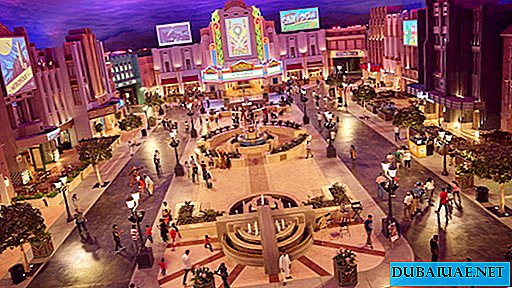ON DECEMBER 2, 2012, EMIRATES WILL FOR THE 41ST TIME CELEBRATE ANNIVERSARY OF AN INDEPENDENCE OF THE UNITED ARAB EMIRATES. THE CELEBRATION WILL LAST FOR MORE WEEKS - FROM NOVEMBER 25 TO DECEMBER 3. ORGANIZERS ARE GOING TO EXCEED THE PAST ANNIVERSARY ANNIVERSARY CELEBRATION. It seems that the desire, without end, to perfect everything that even yesterday seemed to be the peak of perfection, has become a tradition in the emirates.
 Meanwhile, the fortieth anniversary of independence was marked by stunningly large-scale events that reflected the richness of the country's history and culture and the special “Spirit of Union” (“ruh al-ittihad”). It was supposed to be a factor in the unification of indigenous emirates and visitors - all those who somehow connected their fate with the UAE. The integral components of the spirit of the Emirates are the centuries-old traditions of their inhabitants, the legacy of the founder of the state - Sheikh Zayed bin Sultan al Nahyan, as well as the country's aspiration for the future. The spirit of the union is designed to be common to the seven emirates and the entire motley emirate society at a time when the UAE has already crossed the forty-year-old line of "maturity."
Meanwhile, the fortieth anniversary of independence was marked by stunningly large-scale events that reflected the richness of the country's history and culture and the special “Spirit of Union” (“ruh al-ittihad”). It was supposed to be a factor in the unification of indigenous emirates and visitors - all those who somehow connected their fate with the UAE. The integral components of the spirit of the Emirates are the centuries-old traditions of their inhabitants, the legacy of the founder of the state - Sheikh Zayed bin Sultan al Nahyan, as well as the country's aspiration for the future. The spirit of the union is designed to be common to the seven emirates and the entire motley emirate society at a time when the UAE has already crossed the forty-year-old line of "maturity."
The British historian Benedict Anderson calls all communities of people that are larger than the primeval village imaginary. Nations are not the product of certain natural connections and inevitable laws of history. This is what people do, that which they feel belongs to. This is a common cause. In the case of the Emirates, this is especially acute. Why, then, who are today called the Emirates, "imagined" themselves as such?
How did their national “affair”, their well-being and spirit turn out to be genuinely common, and did not serve only the top? How did local residents isolate themselves from their neighbors - the same Arabs from related tribes, Muslims, pearl hunters, merchants, "oil miners" who were under the same British control and also called the Persian Gulf Arab? Finally, why did the forces of unification prevail over the differences between the emirates themselves? The key role was played by various political borders, especially state borders. Throughout the Middle East, it was precisely the states on the ruins of colonialism that created the nation. The UAE is one of the successful examples. It is here that the truly historical significance of the UAE’s Independence Day is revealed - December 2, 1971.

A long way to independence
 Emirates is a young country eagerly eager for the future. But it turns out to be impossible to understand without turning to the past. It is in it that you can find the answers to those questions that are posed above. Over the centuries, the history that led to the creation of the UAE has been determined by two broad trends - the emergence of new political units in Arabia and at the same time the convergence of the sheikhs who are destined to enter modern emirates. From the time of early antiquity, the division of the Persian Gulf region into two lands dates back to Dilmun and Magan. The first included modern Bahrain, Kuwait, Qatar and Al-Hasa in Saudi Arabia, and the second - Oman and the UAE. The mysterious Magan may have kept the famous "Mine of King Solomon" and consisted of several city-states similar to the Greek policies. With the advent of Islam in the 7th century and in the Middle Ages, both regions, which began to be called Bahrain and Oman, respectively, remained isolated and had their governors - vali. By the time of the Thousand and One Nights, the brilliant Caliphate already had little control over the area, giving room to local rulers. Since 1500, Europeans have entered the region: the Portuguese will stay here until 1650, then a short interlude of the Dutch will follow, the British will establish themselves by the end of the 18th century. Meanwhile, the alignment of forces on the coast itself was becoming more complicated. Arabs migrated to two regions from Inner Arabia (the future Saudi state was born in its center) and from the Iranian coast. So, only in the territory of the future Emirates - As-Sirr - 4 tribal unions of 5-15 tribes each, 9-16 clans each came ... Other tribes settled on other lands, including Oman.
Emirates is a young country eagerly eager for the future. But it turns out to be impossible to understand without turning to the past. It is in it that you can find the answers to those questions that are posed above. Over the centuries, the history that led to the creation of the UAE has been determined by two broad trends - the emergence of new political units in Arabia and at the same time the convergence of the sheikhs who are destined to enter modern emirates. From the time of early antiquity, the division of the Persian Gulf region into two lands dates back to Dilmun and Magan. The first included modern Bahrain, Kuwait, Qatar and Al-Hasa in Saudi Arabia, and the second - Oman and the UAE. The mysterious Magan may have kept the famous "Mine of King Solomon" and consisted of several city-states similar to the Greek policies. With the advent of Islam in the 7th century and in the Middle Ages, both regions, which began to be called Bahrain and Oman, respectively, remained isolated and had their governors - vali. By the time of the Thousand and One Nights, the brilliant Caliphate already had little control over the area, giving room to local rulers. Since 1500, Europeans have entered the region: the Portuguese will stay here until 1650, then a short interlude of the Dutch will follow, the British will establish themselves by the end of the 18th century. Meanwhile, the alignment of forces on the coast itself was becoming more complicated. Arabs migrated to two regions from Inner Arabia (the future Saudi state was born in its center) and from the Iranian coast. So, only in the territory of the future Emirates - As-Sirr - 4 tribal unions of 5-15 tribes each, 9-16 clans each came ... Other tribes settled on other lands, including Oman.
Sheikhs of the Nahayyan clan from the Bani Yas Confederation created a headquarters on the island of Abu Dhabi in 1761 - so a year ago, another two and a half centuries dynasty reigned in the country's largest emirate. The British later intervened in complex tribal relations. They will "divide and rule" until their departure in 1971, and this will determine the further fragmentation of the region. England will also successfully balance on the contradictions of the Sadovite Wahhabi rulers and the Ottoman Empire, which only formally controlled the coast. In the XIX century, more and more actively began to make their claims in the Iran region and the great Western powers. In 1893, the first Russian naval ships will enter the Persian Gulf.
Local sheikhs will thus be small hinges of a large political mechanism. In this they are similar to the European Monaco or Liechtenstein - also preserving their independence and prosperous states ... The separation of Oman by different tribes was immortalized when Great Britain began to sign separate agreements in the 19th century with the principalities of As Sirrah and the rulers of the Sultanate of Oman, which itself broke up into 1792 Sultanate Muscat and Imamat Oman. The 1820 treaty assigned the name of Treaty Oman to the future state, under which the emirates were known until independence. The fragmented historical Oman was also followed by the ancient Dilmun: the British actually “created” Kuwait and Bahrain. By the 1860s, the connection between Bahrain and Qatar had already become fiction ... Throughout the second half of the 19th century, skirmishes between the sheikhs will take place - for example, the contractual Oman tribes with Muscatians or Qatari. Separate sheikhs will be declared British protectorates in different years. Istanbul will be especially firmly attached to Qatar and Kuwait formally subordinate to it. At the same time, the first one will not be of strategic interest, and because of the right to lay a railway, world diplomatic crises will erupt in the second emirate. Bahrain will become a global pearl center and a pioneer in education, fiction and the labor movement.
At the beginning of the 20th century, oil will be found in Kuwait, Bahrain and Qatar. Each sheikh will have its own bureaucracy and state symbols ... One of such independent units was the Treaty of Oman. An American missionary and doctor Paul Harrison, a passionate lover of the emirates who visited them more than once in the first half of the 20th century, wrote that "this is the most attractive country of all the Arabian countries, and only their pride can argue with the hospitality of its inhabitants."
Historical choice
 Contractual Oman made the final choice in 1971. Recall that since 1968 the idea of a wider federation was discussed, which would include not only these seven emirates, but also Bahrain and Qatar. The fate of the future UAE was not even clear in terms of the currency used: in the emirates in the 1960s, the Indian rupee, the rupee of the bay, the Saudi riyal (which brought with it the Saudi influence), and finally the Qatari and Dubai rials ... those forces that for more than two centuries have led to the separation of the various states of the gulf have prevailed. In 1971, the UAE included six emirates of Treaty Oman, the next year they were joined by Ras Al-Khaimah. The main event happened: apparently, for many years to come, the political border was determined, within which the emirate society is developing today.
Contractual Oman made the final choice in 1971. Recall that since 1968 the idea of a wider federation was discussed, which would include not only these seven emirates, but also Bahrain and Qatar. The fate of the future UAE was not even clear in terms of the currency used: in the emirates in the 1960s, the Indian rupee, the rupee of the bay, the Saudi riyal (which brought with it the Saudi influence), and finally the Qatari and Dubai rials ... those forces that for more than two centuries have led to the separation of the various states of the gulf have prevailed. In 1971, the UAE included six emirates of Treaty Oman, the next year they were joined by Ras Al-Khaimah. The main event happened: apparently, for many years to come, the political border was determined, within which the emirate society is developing today.
Subsequently, the first president of the UAE, Sheikh Zayed, was able to say that "the union tree is becoming more and more fertile and more deeply rooted; it is an eternal tree for all future generations." From the height of the past years, the choice of the UAE can really be called far-sighted. Slave nationalism did not lead to pan-Arab unification, and the relations of the neighbors in the bay, who are trying to integrate more closely, are still overshadowed by territorial, currency and even espionage disputes and scandals. And it is unlikely that the Emirates would like the internal problems of their country to be contention within Oman or the position of Bahraini Shiites.
The United Arab Emirates, at the time of their founding, also bypassed both violence and the "socialist experiment." Great Britain, having conflicts before its eyes in Yemen and Oman, “let go” of the sheikhs in time, and their small indigenous population, who had already tasted the fruits of the oil era, did not accept the ideas of socialism and set up another - much more successful - experiment ...
Seeking the Spirit of Union
 However, since 1971, the UAE Federation, the most successful in the Arab world, had a long way to go in building the Emirate nation, and much work was still ahead. The end of the same 1971 was overshadowed by the border disputes of Abu Dhabi and Dubai - the pillars of the new state - because of the territory, blood was shed ... And today, every emirate has broad powers, its own budget, its own development strategies, and Dubai and Ras Al Khaimah their courts. In 1991, the main thing for students in the UAE was their Islamic identity, then Arabic, and then Emirate. Until now, the emirate cherishes his nisab - blood origin.
However, since 1971, the UAE Federation, the most successful in the Arab world, had a long way to go in building the Emirate nation, and much work was still ahead. The end of the same 1971 was overshadowed by the border disputes of Abu Dhabi and Dubai - the pillars of the new state - because of the territory, blood was shed ... And today, every emirate has broad powers, its own budget, its own development strategies, and Dubai and Ras Al Khaimah their courts. In 1991, the main thing for students in the UAE was their Islamic identity, then Arabic, and then Emirate. Until now, the emirate cherishes his nisab - blood origin.
Nevertheless, the unifying factors prevailed. Abu Dhabi and Dubai, without imposing their dominance, became natural landmarks and donors for the small emirates. Their rulers are not only the official leaders of the federation, but also its true builders. In the 1970s, when the territorial disputes of Dubai and Sharjah led to clashes, Sheikh Zayed threatened that he would not be re-elected president. Opponents listened to him and reconciled ...
Crises - for example, the recent financial crisis - only strengthened the union. The far-sighted builders of the federation have directed the country's wealth into areas that are most important for national consciousness. Emirates have become physically easier to travel around the country thanks to the development of infrastructure. Stunning construction projects, as if structuring the space of cities, cannot but arouse pride and a sense of belonging to the common success. Citizens are united by broad social programs, and now even the middle classes can afford the lifestyle previously available only to the upper classes. Education (it accounts for more than 20% of the federal budget) develops a sense of belonging to the nation.
 Associations associated with folk art receive the most assistance from the government. It is they who are busy reviving local historical traditions. Throughout the UAE, you can see images of a falcon, a camel, a pearl shell, a dalla coffee pot, date palms. These images, common to many Arab countries, now tell the Emirates precisely about their past, severe and beautiful in its simplicity. They compare the same past with an abundant present ... The government paid great attention to the development of national consciousness in the strategy of Ru'ya-2021 (Vision 2021) - which, if not striving for the future, unites! - and the project "Vatani" ("patriot, native, native"). Finally, the values of moderate Islam, supported by the leadership, are called upon to be the basis of national consensus on religious issues. By the way, all this unites the emirate old people and the intelligentsia, sometimes yearning for the past, middle-aged people - peers of a staggering boom in development, and young people who often want to touch semi-telling antiquities again ...
Associations associated with folk art receive the most assistance from the government. It is they who are busy reviving local historical traditions. Throughout the UAE, you can see images of a falcon, a camel, a pearl shell, a dalla coffee pot, date palms. These images, common to many Arab countries, now tell the Emirates precisely about their past, severe and beautiful in its simplicity. They compare the same past with an abundant present ... The government paid great attention to the development of national consciousness in the strategy of Ru'ya-2021 (Vision 2021) - which, if not striving for the future, unites! - and the project "Vatani" ("patriot, native, native"). Finally, the values of moderate Islam, supported by the leadership, are called upon to be the basis of national consensus on religious issues. By the way, all this unites the emirate old people and the intelligentsia, sometimes yearning for the past, middle-aged people - peers of a staggering boom in development, and young people who often want to touch semi-telling antiquities again ...
 The Emirates did not have a shortage in the unchanged companion of the formation of the image of “Myself” - “Others”. Moreover, the "other" were not only neighboring small monarchies, powerful Saudi Arabia and Iran, or pro-Soviet Arab states. The closest "other" emirates are immigrants. Dubai has long been cosmopolitan, now the indigenous people in the UAE are no more than 15%. All development strategies of the country take into account the role of foreigners. Many of them could be called stateless emirates: they are part of the UAE's success, their cultures are mixed with the local one. In the foreseeable future, despite some plans to reduce the share of immigrants, indigenous people will not make up the majority in the country. The "spirit of union" must be strong enough to prevent imbalances in this area.
The Emirates did not have a shortage in the unchanged companion of the formation of the image of “Myself” - “Others”. Moreover, the "other" were not only neighboring small monarchies, powerful Saudi Arabia and Iran, or pro-Soviet Arab states. The closest "other" emirates are immigrants. Dubai has long been cosmopolitan, now the indigenous people in the UAE are no more than 15%. All development strategies of the country take into account the role of foreigners. Many of them could be called stateless emirates: they are part of the UAE's success, their cultures are mixed with the local one. In the foreseeable future, despite some plans to reduce the share of immigrants, indigenous people will not make up the majority in the country. The "spirit of union" must be strong enough to prevent imbalances in this area.
In the future, the Emirates will face many challenges. Does the concept of nation in our global era make sense? Whom should she include - local or all who work for her good? Is it compatible with weak political participation? One thing is certain: 41 years ago, a powerful foundation was laid for a grandiose project on which talented people will be able to erect an amazing building.










